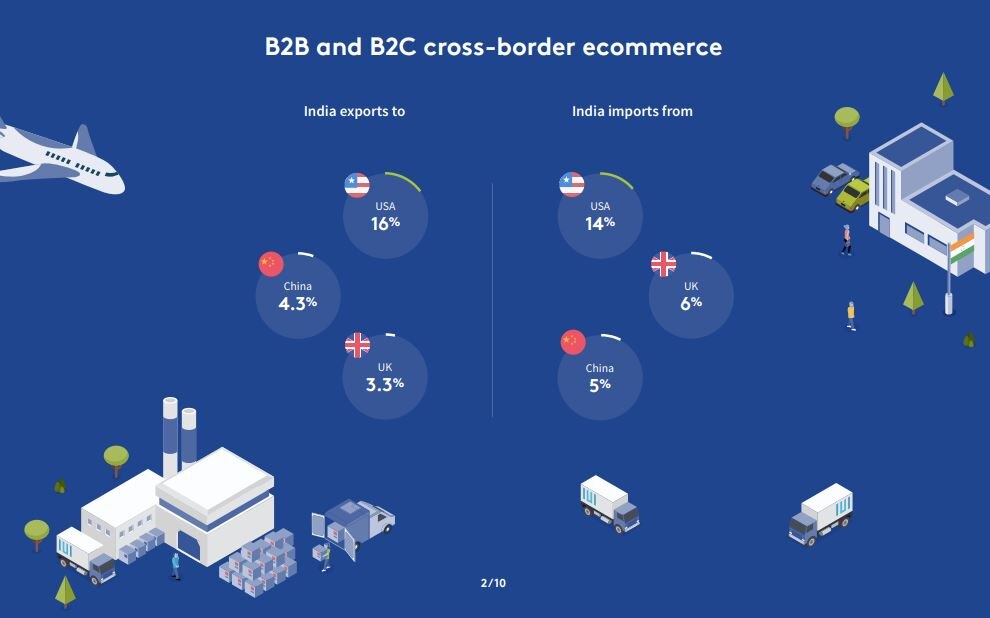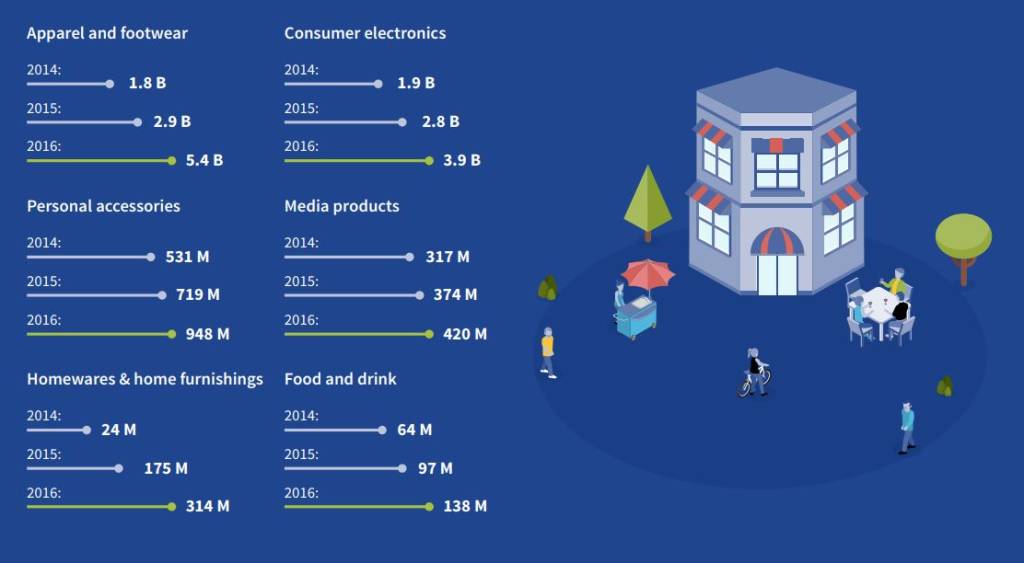Explorer
Cross border e-commerce: How this new trade model is helping Indian SMEs reach global customers
Growing smartphone penetration and easy access of high-speed internet have resulted in e-commerce boom across the country over past one decade. Rapid strides in the e-commerce sector within the country has made it a viable platform for trade, accessible to ordinary retail buyers and sellers separated geographically, who would otherwise not have contemplated any transaction between themselves.

As e-commerce has become one of the most evolving segments, now it’s time to cross the border and reach out to global audience. (Image: AFP)
Growing smartphone penetration and easy access of high-speed internet have resulted in e-commerce boom across the country over past one decade. Rapid strides in the e-commerce sector within the country has made it a viable platform for trade, accessible to ordinary retail buyers and sellers separated geographically, who would otherwise not have contemplated any transaction between themselves. The major beneficiaries of this new-age retail model are the SMEs who have now overstepped the geographical barriers to access global market with higher margins. As e-commerce has become one of the most evolving segments, now it’s time to cross the border and reach out to global audience. As India quickly begins to adopt e-commerce, small retailers can now also look globally to grow their operations. According to a recent study, for products that can be traded through B2C e-commerce such as jewellery, leather goods, handloom and handicrafts there is an available $52 bn market opportunity. Riding on the back of high consumer expectation in terms of pricing and quality, cross-border e-commerce in India is estimated to reach $ 2 bn by 2020 from $ 500 mn in 2016. “Across the globe Cross Border E-commerce is growing at 17 per cent compared to domestic E-commerce and is projected to reach US$ 1 trillion by 2021. SMEs contribute to approximately 50 per cent of domestic e-commerce but are able to get to only 5 per cent when looking at exports. India , with 50 million registered SMEs stands to gain most by the momentum due to the large range of diverse categories that Indian artisans are able to churn out," said Sanjay Keswani, Director (Global Platform and Strategic Alliances) of Eunimart, a Cross border E-commerce startup using Artificial Intelligence (AI) technology to enable small merchants sell internationally. According to a recent report by news agency PTI, smartphones are popular in Arab countries and local consumers have strong purchasing power. But the oil-rich countries lack textiles and other light sectors, offering cross-border e-commerce opportunities for products like apparel. A study conducted by Acapture states that India exports 16 per cent products to the US, 4.3 per cent to China and 3.3 per cent to UK using cross-border e-commerce channel. Likely when it comes to import, it gets 14 per cent of products from the USA, 6 per cent from the UK and 5 per cent from China.  (Image: Acapture) The research firm also listed out the in-demand categories with the overall business (in US dollars)
(Image: Acapture) The research firm also listed out the in-demand categories with the overall business (in US dollars)  (Image: Acapture) By shifting gears to cross border e-commerce model, SMEs will be able to access a larger pool of global consumers. Through traditional export, companies typically focus their efforts on few geographies, however, cross border e-commerce allows companies to attract customers from even remote locations, with whom there is not much trade with India. “After witnessing a slowdown in 2015 and 2016, 2017 has seen a reinvigoration of the worldwide e-commerce market, which, in turn, has seen a return
to the optimism of previous years. In fact, the compound annual growth rate predicted for cross - border e-commerce for 2017 to
2022 now stands at 17 per cent, which is higher than the 12 per cent growth rate for e-commerce overall. That indicates that the cross-border market is now developing faster than domestic online retail,” Keswani said adding that such marketplaces act as the gatekeepers of the country's retail trade. Better prices, specific goods not being available in their home country and need to try and experience something different drives the demand of cross-border e-commerce. Conclusion: The cross border e-commerce model is the future of online shopping and it is here to stay. It needs to be considered accordingly as a growth strategy for an e-commerce business. Looking at the current scenario, cross border e-commerce needs investment (payment processing, staff and logistics) and should be done in a staged manner for maximum output.
(Image: Acapture) By shifting gears to cross border e-commerce model, SMEs will be able to access a larger pool of global consumers. Through traditional export, companies typically focus their efforts on few geographies, however, cross border e-commerce allows companies to attract customers from even remote locations, with whom there is not much trade with India. “After witnessing a slowdown in 2015 and 2016, 2017 has seen a reinvigoration of the worldwide e-commerce market, which, in turn, has seen a return
to the optimism of previous years. In fact, the compound annual growth rate predicted for cross - border e-commerce for 2017 to
2022 now stands at 17 per cent, which is higher than the 12 per cent growth rate for e-commerce overall. That indicates that the cross-border market is now developing faster than domestic online retail,” Keswani said adding that such marketplaces act as the gatekeepers of the country's retail trade. Better prices, specific goods not being available in their home country and need to try and experience something different drives the demand of cross-border e-commerce. Conclusion: The cross border e-commerce model is the future of online shopping and it is here to stay. It needs to be considered accordingly as a growth strategy for an e-commerce business. Looking at the current scenario, cross border e-commerce needs investment (payment processing, staff and logistics) and should be done in a staged manner for maximum output.
 (Image: Acapture) The research firm also listed out the in-demand categories with the overall business (in US dollars)
(Image: Acapture) The research firm also listed out the in-demand categories with the overall business (in US dollars)  (Image: Acapture) By shifting gears to cross border e-commerce model, SMEs will be able to access a larger pool of global consumers. Through traditional export, companies typically focus their efforts on few geographies, however, cross border e-commerce allows companies to attract customers from even remote locations, with whom there is not much trade with India. “After witnessing a slowdown in 2015 and 2016, 2017 has seen a reinvigoration of the worldwide e-commerce market, which, in turn, has seen a return
to the optimism of previous years. In fact, the compound annual growth rate predicted for cross - border e-commerce for 2017 to
2022 now stands at 17 per cent, which is higher than the 12 per cent growth rate for e-commerce overall. That indicates that the cross-border market is now developing faster than domestic online retail,” Keswani said adding that such marketplaces act as the gatekeepers of the country's retail trade. Better prices, specific goods not being available in their home country and need to try and experience something different drives the demand of cross-border e-commerce. Conclusion: The cross border e-commerce model is the future of online shopping and it is here to stay. It needs to be considered accordingly as a growth strategy for an e-commerce business. Looking at the current scenario, cross border e-commerce needs investment (payment processing, staff and logistics) and should be done in a staged manner for maximum output.
(Image: Acapture) By shifting gears to cross border e-commerce model, SMEs will be able to access a larger pool of global consumers. Through traditional export, companies typically focus their efforts on few geographies, however, cross border e-commerce allows companies to attract customers from even remote locations, with whom there is not much trade with India. “After witnessing a slowdown in 2015 and 2016, 2017 has seen a reinvigoration of the worldwide e-commerce market, which, in turn, has seen a return
to the optimism of previous years. In fact, the compound annual growth rate predicted for cross - border e-commerce for 2017 to
2022 now stands at 17 per cent, which is higher than the 12 per cent growth rate for e-commerce overall. That indicates that the cross-border market is now developing faster than domestic online retail,” Keswani said adding that such marketplaces act as the gatekeepers of the country's retail trade. Better prices, specific goods not being available in their home country and need to try and experience something different drives the demand of cross-border e-commerce. Conclusion: The cross border e-commerce model is the future of online shopping and it is here to stay. It needs to be considered accordingly as a growth strategy for an e-commerce business. Looking at the current scenario, cross border e-commerce needs investment (payment processing, staff and logistics) and should be done in a staged manner for maximum output. Related Video
Union Budget 2025: Arvind Kejriwal lists the shortcomings of the Modi government's budget | ABP News | AAP
Follow Business News on ABP Live for more latest stories and trending topics. Watch breaking news and top headlines online on ABP News LIVE TV

Dr Prosenjit NathThe writer is a technocrat, political analyst, and author.
Opinion




































